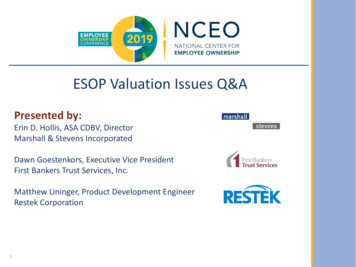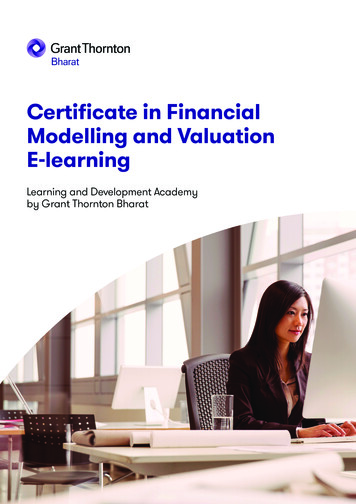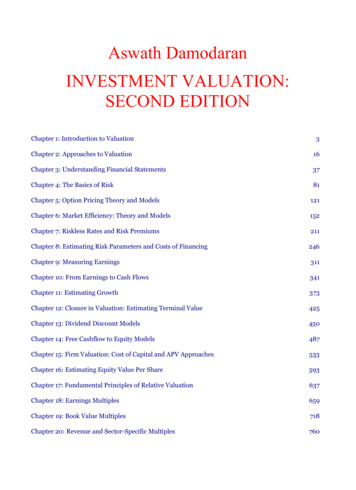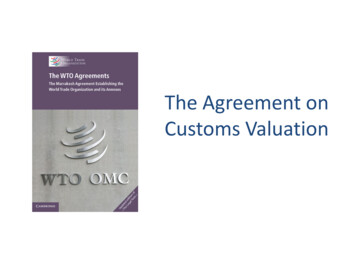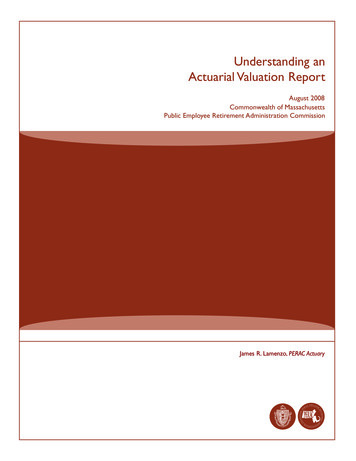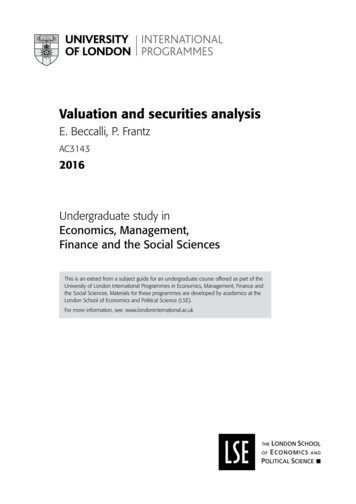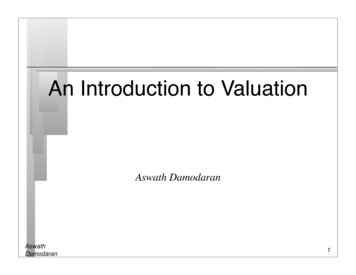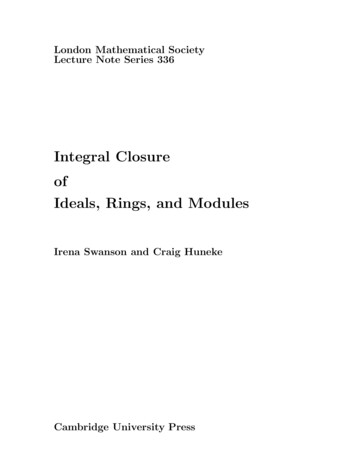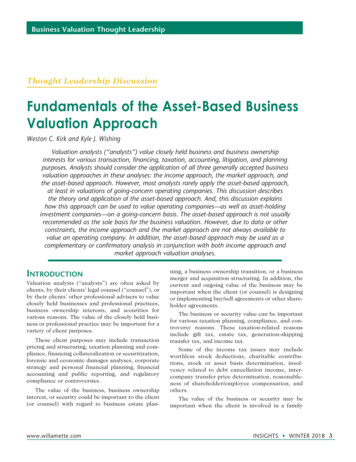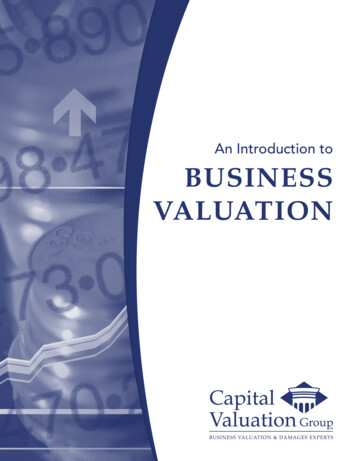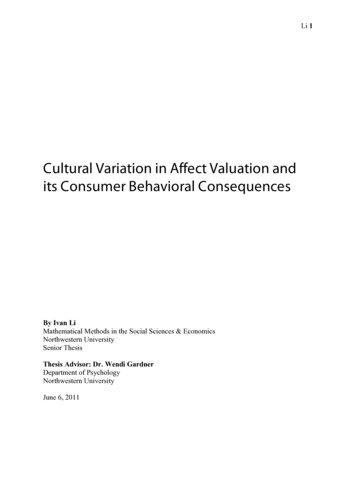
Transcription
Li 1Cultural Variation in Affect Valuation andits Consumer Behavioral ConsequencesBy Ivan LiMathematical Methods in the Social Sciences & EconomicsNorthwestern UniversitySenior ThesisThesis Advisor: Dr. Wendi GardnerDepartment of PsychologyNorthwestern UniversityJune 6, 2011
Li 2ContentsAcknowledgements3Abstract (Summary)4Introduction5Literature Review6The Meaning(s) of Happiness and the Concept of Ideal AffectHappiness and Choice69Overview12Study 113MethodologyResults & Discussion1315Study 217MethodologyResults & Discussion1717General Discussion and Implications21Appendix23Appendix A1: High-arousal & Low Positive Advertisements (Cookie)Appendix A2: High-arousal & Low Positive Advertisements (Water)Appendix A3: High-arousal & Low Positive Advertisements (Cold Medicine)Appendix A4: High-arousal & Low Positive Advertisements (Shampoo)Appendix B: Affect Valuation Index – Measuring Ideal AffectAppendix C: Singelis Prescreen – Measuring Independent vs. Interdependent Self-Construal232425262728References29
Li 3AcknowledgementsI would like to first thank my thesis advisor, Dr. Wendi Gardner. Her knowledge in the fieldand her confidence in me made the thesis process possible and a success. I would also like toextend my thanks to Professor Michelle Weinberger for her guidance and help at the initialstage. I also would like to thank Professor Joseph Ferrie, Professor William Rogerson, andProgram Assistant Sarah Muir Ferrer for providing me with an extremely rewarding andvaluable education through the MMSS program.Finally, I wish to acknowledge my friends and family who supported and encouraged methroughout this thesis process, with a special thanks to Elise Bourdeau and Adit Kumar.Thank you very much, everyone.
Li 4AbstractAmidst a recovering economy whose recent turmoil has effectively wrecked the lives ofmany, the promise of happiness has reasserted itself in the business world’s public dialogue.Marketers have recently increased their focus on promoting happiness, promising thatpositive feelings can be directly derived from acquiring and using their products. But whileconsumers might all want to be happy, a growing body of research suggests that happinessmanifests itself very differently among individuals, and can be ordered into two categories —high-arousal positive affect, and low-arousal positive affect. Towards this end, previousstudies suggest that cultural factors influence ideal affect (i.e., the affective states that peopleideally want to feel), and individual’s definition of happiness and ideal affect can impact thechoices they make. This study examined the role of ideal affect valuation in shaping howconsumers respond to advertisements and brands across cultures. In Study 1, EuropeanAmerican, South Asian, and East Asian females showed general support towards culturaldifferences in ideal affect, and consumer valuation differences when exposed to ads ofvarying degree of affective promises. In Study 2, East Asian females demonstrated a greaterinterest in the advertisements that showed a low-arousal positive affect, than those who wereexposed to almost identical advertisements of the same product that showed a high-arousalpositive affect. Moreover, images were more effective in eliciting a difference in responsethan words, which underscored the ability of images to effectively communicate affectivestates to the viewer. These findings suggest that cultural differences in ideal affect do play arole in shaping how consumers evaluate brands and their advertisements, and that the form ofcommunication (words vs. images) can influence response.
Li 5IntroductionHow does culture shape consumer choices? Imagine yourself an executive in chargeof marketing your company’s product to a new consumer pool from a foreign culture. Whatconsiderations will you need to be aware of? How should you present your brand and productto become relevant and appealing to this new target customer group?Amidst a recovering economy whose recent turmoil has effectively wrecked the livesof many, the promise of happiness has reasserted itself in the business world’s publicdialogue. Marketers have recently increased their focus on promoting happiness, promisingthat positive feelings can be directly derived from acquiring and using their products.Examples of this practice are numerous: Hugh Boss offers “Orange, the fragrance ofhappiness,” while VISA promotes “Happiness Verified by VISA.” Likewise, the Coca-ColaCompany has inaugurated an “Open Happiness” campaign, entreating consumers to enjoy thesimple pleasures of life and to share their happiness with others.Happiness appears to be a universal message appropriate for cross-cultural consumergoods. Most people like to feel happy (Larsen, 2000), yet the ways in which this state isachieved vary significantly. Surely psychologists, economists, and political scientists havemade significant progress in determining scientific measures of happiness, ways to increase itas well as the importance of being happy (Diener and Chan 2011; Diener and Seligman 2002;Dunn, Akin, and Norton 2008; Easterline 2003; Kahneman et al. 2004, 2006; Lyubomirsky,Sheldon, and Schkade 2005; Mogilner 2010; Van Boven and Gilovich 2003). Yet, we stilllack a strong empirical understanding of what “happiness” means, and to what extent it couldhave different meaning across cultures and individuals.Indeed, a growing body of research suggests that happiness manifests itself verydifferently among individuals, and that our idea of happiness varies significantly from that of
Li 6our peers. While this line of research remains thin, even sparser is the research exploringwhether and how differences in definitions of happiness across individuals can affect theirown consumer choices. Is happiness truly universal in how it affects our decisions? Or does italso depend on how the promise of happiness is described and framed, and what it means tothe consumer?In a rapidly globalizing world where happiness is becoming an increasingly importantelement of marketers’ value proposition, we still know little about how definitions ofhappiness differ culturally and how happiness itself affects choices. Across cultures, we seepeople engaging in vastly different mood-producing behaviors to enter a happy state; willconsumers from different cultures choose happiness-inducing products differently too?The definition of culture used in this thesis is that which recognizes that cultureincorporates a set of learned values ranging from customs, language, material artifacts,attitudes and beyond (Radnor & Strauss, 2011). Understanding how cross-culturalconsumers’ definition of happiness change is helpful, but being able to pinpoint culturalfactors that determine the definition of happiness will yield a wider set of application.Toward this, we ask, what are the underlying factors that might explain how culturaldifferences impact an individual’s definition of happiness and how it determines consumerbehaviors?In order to address these questions, I report the results of a set of studies that apply tothe subject matter at hand.The Meaning(s) of Happiness and the Concept of Ideal AffectIs Happiness universal? While some researchers see Happiness as a universal andsingular message consistent across individuals, others suggest that it is highly subjective, and
Li 7can take on different individual meanings (Myers and Diener 1995; Layard 2005; Gilbert2006). A third and smaller stream of research argues that there are multiple types ofHappiness, and these types can be endorsed and viewed differently in function of age(Mogilner et al. 2011) and culture (Tsai, Knutson, and Fund 2006).To understand the different types of happiness requires an understanding of affectivestates. Affective states are neurophysiologic phenomena that produce emotions, feelings ormoods, and can be classified into two categories: valence and arousal (Feldman Barrett &Russell, 1999; Larsen & Diener, 1992; Russell, 1991; Thayer, 1989; Watson & Tellegen,1985). The valence category encompasses feelings that respond to potential gains (positivevalence) or losses (negative valence), while the arousal category describes feelings thatrequire energy and mobilization (high arousal) or allow rest and recuperation (low arousal;Russell, 2003). Various studies have shown that different feeling states can be defined andordered in terms of the above-mentioned affective categories (e.g., Kuppens, Ceulemans,Timmerman,Diener, & Kim-Prieto, 2006; Yik & Russell, 2003). For example, enthusiasm,elation, and excitement can be grouped as high-arousal positive (HAP) states, and tranquility,serenity, and peacefulness can be grouped as low-arousal positive (LAP) states (Tsai, 2007).While the psychology community focuses heavily on the actual affective states thatpeople experience (their actual affect), little attention has been placed towards the idealaffective states they would like to feel (their ideal affect). To measure the existence of idealaffect, Jeanne Tsai and Brian Knutson developed the affect valuation index (AVI), and foundthat how their respondents actually feel differs from how they ideally want to feel, hencesupporting the existence of ideal affect (Tsai, Knutson, & Fung, 2006).What is interesting within this body of research is that researchers found evidence thatsuggests individuals endorse ideal affect differently. Some look for high-arousal positiveemotions, for example excitement and elation, while others are more interested in low-
Li 8arousal positive emotions such as peacefulness and calmness. The two most prevalentexplanations for this variation relate to age and culture. Through a study of over 70,000expressions of happiness in personal blogs, Mogilner et al. (2011) revealed that the meaningof happiness tends to shift across ages, where young bloggers tend to define happiness as ahigh-arousal positive feeling, and older bloggers tend to define happiness as a low-arousalpositive feeling.Likewise, cultural differences also emerged as plausible explanations for crosscultural differences in ideal affect valuation (Tsai, Knutson, & Fung, 2006). To test thishypothesis, Tsai, Knutson, & Fung (2006) surveyed a group of European Americans (EA),Asian Americans (AA), and Hong Kong Chinese (CH) undergraduate students, and foundthat EA and AA individuals value HAP states more than CH individuals do. At the sametime, CH and AA individuals value LAP states more than EA individuals do. Thus, one’sparticular definition of happiness and one’s ideal affect may stem from the culture that he hasbeen raised in and systematically exposed to.Thus, differences in perception of ideal affect were found to emerge early in life andto be culturally learned. To further this hypothesis, Tsai et al. (2007) conducted three studiesexploring whether cultural differences in ideal affect emerged early in life and were acquiredthrough exposure to storybooks. They found that cultural differences in ideal affect wereexhibited by preschoolers and consistent with previous studies. They also found that thesedifferences were influenced by imagery present in storybooks presented to the children.Finally, they also found evidence that across cultures, exposure to exciting (vs. calm)storybooks influenced children’s preferences towards excited (vs. calm) activities and theirideal affect endorsements. Thus, culture can play a critical role in determining howindividuals value ideal affective states, even at a very young age.
Li 9These findings underscore the importance of the role that culture can play ininfluencing one’s own meaning of happiness and ideal affect valuations, which leads to myfirst hypothesis. I propose that when people are more exposed to an American culture (eitherthrough their own ethnicity or years lived in America), they will value high-arousal positive(HAP) states more. However, when people are more exposed to an Asian culture (eitherthrough their own ethnicity or years lived in Asian countries), they will value low-arousalpositive (LAP) states more.H1: Cultural orientation impacts one’s valuation of ideal affective states, whereby (a)orientation to an American culture increases the tendency to value HAP states morethan LAP states; and (b) orientation to Asian cultures increases the tendency to valueLAP states more than HAP states.Happiness and ChoiceBecause we generally want to be happy (Larsen, 2000), what we choose to do toachieve that happiness can differ according to the way we define happiness and how we valueideal affective states. In support of this thought, Tsai (2007) suggests that ideal affectrepresents a goal; it has great motivational force and has the potential to strongly alterbehavior. She finds that cultural differences in ideal affect correspond with predictedbehavioral consequences in leisure activities and drug use. Americans are found to take partin activities that produces HAP states more frequently than East Asians do, while East Asiansare found to take part in activities that produces LAP states more frequently than Americansdo. But a question remains - how do cultural differences in ideal affect impact consumerchoices?
Li 10While some markets operate under the assumption that happiness is the universalmessage and promise that all consumers are looking for, research shows that happiness issimply one of the many drivers behind choice (Benjamin et al. 2011). To explore howhappiness impacts choice, Mogilner et al. (2011) conducted a series of studies that identifytemporal focus to be a factor that influences the type of happiness one experiences, andconsequently choice. In one study, they asked a sample of younger adults and older adults tolisten to both an exciting and calming version of a song, to record how happy they felt duringthe song and their temporal focus, and to pick a version of the song as an additional thankyou. They conclude that what happiness represents to an individual can impact their choice,and that their definition of happiness can be altered through a shift of temporal focus. Forthose individuals who defined happiness as more exciting than calm, they chose the song thatwas more exciting. For those individuals who defined happiness as more calm than excited,they chose the song that was calmer.These findings underscore the importance of the definition of happiness in its abilityto influence choice. What is lacking however is an understanding of how differences inculture or a shift in cultural focus can impact choice. I hypothesize that the extent to whichone is closer to Asian cultures or an American culture will determine which ideal affect stateone values more, and thus whether a calming or exciting option will be more valued by theindividual. Specifically, if an individual is more culturally oriented towards Asian cultures,LAP states will be preferred over HAP states, so he should be more interested in an optionthat promises or results in calmness. However, if an individual is more culturally associatedwith an American culture, HAP states are valued over LAP states, so consumers should bemore interested in an option that promises or engenders excitement.
Li 11H2: Cultural orientation impacts choice, whereby (a) orientation to Asian culturesincreases the tendency to choose a calming option over an exciting option; and (b)orientation to an European American culture increases the tendency to choose anexciting option over a calming option.Culture is also a broadly defined variable. Previous studies have hypothesized thatdifferences in ideal HAP states endorsement and ideal LAP sates endorsement could bepartially explained by differences in self-construal between independence andinterdependence. I hypothesize that how one defines their self-construal will determine whichideal affect states they value more, and thus whether a calming or exciting option will bemore appealing and of interest. Specifically, if an individual is more socially interdependent,LAP states is valued over HAP states, so he should be more interested in an option thatpromises or exhibits calmness. Thus, interdependent consumers should tend to choose morecalming options. However, if an individual is more independent, HAP states are valued overLAP states, so consumers should be more interested in an option that promises or exhibitsexcitement. Thus, independent consumers should tend to choose more exciting options.H3: Interdependence vs. Independence self-construal helps impact choice, whereby(a) orientation to an interdependence self-construal increases the tendency to choose acalming option over an exciting option; and (b) orientation to an independence selfconstrual in increases the tendency to choose an exciting option over a calmingoption.
Li 12OverviewTo test these three hypotheses, I recruited two samples of participants, one a broadadult sample and one a college age sample. Both were administered the same survey,evaluating advertisements for various products, presented in high or low arousing positiveways. Each participant was exposed to four different advertisements, and we measured howthey evaluated the brand and the ad, as well as some demographic information, how theyvalued ideal affective states, and their interdependence vs. independence mode of selfconstrual. The two studies hoped to extend previous studies in three ways. First, we hoped toexplore how participants directly respond to advertisements. Second, we hoped to explore thedifferences in representations of happiness, either conveyed through words or images.Specifically, each participant will be exposed to 4 distinct kinds of advertisements - one ofwhich will promise HAP states through words, one of which will promise HAP states throughan image, one of which will promise LAP states through words, and one of which willpromise LAP states through an image. Finally, the existing literature has focused primarilyonly on differences between European American and East Asian (e.g., China, Japan) cultures,in the first study we also explored potential cultural differences in HAP and LAP amongSoutheast Asians (e.g., India) as well.Two studies were thus conducted. In Study 1, the study recruited a broad sample ofadults online representing European American, South Asian, and East Asian ethnicbackgrounds. In Study 2, the study recruited college students of European American or EastAsian ethnicities. In both studies the advertisements presented, as well as the dependentvariables assessed, were identical.
Li 13Study 1: MethodAd Set Development. To enhance external validity, eight advertisements on fourproducts were specifically designed for this study. To minimize prior brand and productaffinity, generic products were chosen. Those specific products were cookies, bottled water,shampoo, and cold medicine Each product was showcased in two ads, each one containing adifferent endorsement of ideal affective state, presented by triggers of the same category(words vs. image). For example, the water ads had two variations. In the exciting version, animage of a water bottle was shown, along with the following advertising message “Now withan exciting taste of lemon.” In contrast, the calming version showed an image of a waterbottle accompanied by the tagline; “Now with a calming taste of lemon.” Likewise, theshampoo ads had two variations. In the exciting version, it read, “have beautiful hair”, andfeatured a woman displaying a very elated and excited laugh. In contrast, the calming versionread, “have beautiful hair”, and featured the same woman shot at the same angle with a verycalming, closed-mouth smile.Within each set, the participants saw four ads pertaining to the four products — bothimage and verbal triggers were used to convey HAP and LAP respectively, resulting in a totalof four total trigger/state combinations.Participants. One hundred and twenty-six European American females, seventySoutheast Asian females, and thirty-three East Asian females were recruited throughAmazon’s mechanical-turk and participated in an online survey. The participants eachreceived a 2.02 online credit for their participation.Instruments. Two distinct variables were used to measure how effective each ad wasin communicating with the participants. The first measure, termed Ad Appeal Index, aims toassess the participants’ general impression of the ad. Participants were asked to rate the ad on
Li 14one seven-point scale anchored by “Not at all appealing”/”Very appealing”. The secondmeasure, termed Brand Affinity Index, taps the participants’ level of brand affinity.Specifically, they were asked to indicate whether they would consider buying the product,how willing they were to learn more about the product, and how willing they were to benotified for future promotion / coupons. They were asked to answer these three questions onthree seven-point scales anchored by “Would definitively not consider buying it”/”Woulddefinitely consider buying it”, “Not at all willing”/”Very willing”.To measure ideal affect, participants were to answer the AVI Index, developed byTsai, Knutson, & Fung (2006). Participants were asked to “rate how often you wouldIDEALLY like to have that feeling” of each of 30 items “over the course of a typical week”,by using a scale ranging from 1 (never) to 5 (all the time). We then calculated meanaggregate scores of items from each octant of the affective complex.To measure whether group differences were due to independence-interdependence,participants completed the Prescreen developed by Singelis (1994). Participants rated howstrongly they agreed with statements assessing independence (e.g. “I prefer to be direct andforthright when dealing with people I’ve just met.”) as well as interdependence (e.g. “I willsacrifice my self-interest for the benefit of the group I am in.”) using 24 seven-point scales,each anchored by “Strongly disagree”/”Strongly agree”.As for demographics information, the participants reported their age, ethnicity, andnumber of years lived in US, in a Southeast Asian country, and in an East Asian country.Procedure. After collecting demographic information, participants were randomlyassigned to one of two ad sets. Each ad within the set appeared in a random fashion tocontrol for possible order effects. The participants were asked to evaluate each ad using theAd Appeal Index and the Brand Affinity Index. Afterwards, they were shown the AVI Indexand the independence-interdependence scale.
Li 15Results and DiscussionTo explore the cultural differences in ideal affect endorsement, I conducted a repeatedmeasures ANOVA with ideal affect type (high-arousal affect vs. low-arousal affect) as awithin-subject factor and culture (European American vs. Southeast Asian vs. East Asian) asa between-subject factor. There was a significant interaction between affect type andethnicity type, F(2,226) 17.66, p 0.001. In contrast to our hypothesis, European American(EuA) females endorsed HAP states (M 3.74) less than they did with LAP states (M 4.16). Southeast Asian (SA) females endorsed HAP states (M 3.77) more than they did withLAP states (M 3.50). On the other hand, East Asian females (EA) females endorsed LAPstates (M 3.64) more than they did with HAP states (M 3.43). Unexpected response biaswas found in the main effect of ethnicity, F(2, 226) 9.979, p 0.001, EuA females gavehigh endorsement generally (M 3.951) than did SA females and EaA females (Ms 3.635and 3.539, respectively). Pair-wise comparison showed that SA females gave higherendorsements to HAP states (M 3.77) than EaA females did (M 3.43), t(101) 2.167, p 0.05.To explore the cultural differences in independence vs. interdependence selfconstrual, I conducted a repeated measures ANOVA with self-construal type (independencevs. interdependence) as a within-subject factor and culture (EuA vs. SA vs. EaA) as abetween-subject factor. There was a significant interaction between self-construal type andculture, F(2, 226) 5.837, p 0.01. Similar to previous studies, EuA females sawthemselves as more independent than interdependent (Ms 4.92 and 4.63, respectively),whereas SA females saw themselves as more interdependent than independent (Ms 5.14and 5.00, respectively). Finally, EaA females saw themselves as more interdependent than
Li 16independent (Ms 4.80 and 4.57, respectively). Unexpected response bias was found in themain effect of ethnicity, F(2,226) 7.711, p 0.001, SA females gave high endorsementgenerally (M 5.064) than did EuA females and EaA females (Ms 4.78 and 4.68,respectively). Pair-wise comparison showed that EuA females defined themselves as moreindependent (M 4.92) than EaA females did (M 4.63), t(157) 2.416, p 0.05.Of central interest, I conducted a repeated measures ANOVA with Ad Appeal Indexfrom each ad type (WrdHApl vs. WrdLApl vs. ImgHApl vs. ImgLApl) as a within-subjectfactor and culture (EuA vs. SA vs. EaA) as a between-subject factor to explore howdifferences in culture will alter consumer valuation on ad appeal with varying degrees ofaffective promises. Mauchly’s Test indicated that the assumption of sphericity had beenviolated, χ2 (5) 21.08, p 0.001, therefore degrees of freedom were corrected usingHuynh-Feldt estimates of sphericity (ε 0.96). The results showed a significant interactionbetween Ad Appeal Index from each ad type and culture, F(5.66, 654.10) 2.91, p 0.01.Pair-wise comparison showed that SA females gave higher endorsements to both high arousalimage ad and low-arousal image ad (Ms 5.64 and 5.17, respectively) than EuA females did(Ms 4.84 and 4.56, respectively), t(194) 3.58, p 0.001, and t(194) 2.66, p 0.01,respectively. Likewise, pair-wise comparison also showed that SA females gave higherendorsements to the high-arousal-image ad (M 5.64) than EaA females did (M 4.94),t(194) 2.18, p 0.05.To continue, I conducted a repeated measures ANOVA with Brand Affinity Indexfrom each ad type (WrdHBrd vs. WrdLBrd vs. ImgHBrd vs. ImgLBrd) as a within-subjectfactor and culture (EuA vs. SA vs. EaA) as a between-subject factor to explore howdifferences in culture will alter consumer affinity towards brand with varying degrees ofaffective promises. Mauchly’s Test indicated that the assumption of sphericity had beenviolated, χ2 (5) 37.93, p 0.001, therefore degrees of freedom were corrected using
Li 17Huynh-Feldt estimates of sphericity (ε 0.92). The results did not show a significantinteraction between Brand Affinity Index from each ad type and culture, F(5.50, 620.72) 1.83, p 0.05.Together these results show general support towards cultural differences in idealaffect, independence-interdependence self-construal, and consumer valuation differenceswhen exposed to ads of varying degree of affective promises across these participants.Study 2: MethodParticipants. Forty-nine European American females, forty-nine East Asian femaleswere recruited through from a large Midwestern University. The participants entered into alottery drawing for 50 in cash for their participation.They completed the same survey as the study 1 participants, followed the sameprocedure, viewed the same ad sets, and were measured by the same instruments.Results and DiscussionTo explore the cultural differences in ideal affect endorsement, I conducted a repeatedmeasures ANOVA with ideal affect type (high-arousal affect vs. low-arousal affect) as awithin-subject factor and culture (European American vs. East Asian) as a between-subjectfactor. The results did not show a significant interaction between affect type and ethnicitytype, F(1,94) 0.38, p 0.05. Although non-significant, the pattern of cultural differences inideal affect endorsements were in line with previous studies. EuA females endorsed HAPstates slightly but non-significantly higher than they did with LAP states (Ms 4.02 and 3.98,
Li 18respectively), while EaA females endorsed LAP states slightly and non-significantly higherthan they did with HAP states (Ms 3.89 and 3.84, respectively).To explore the cultural differences in independence vs. interdependence selfconstrual, I conducted a repeated measures ANOVA with self-construal type (independencevs. interdependence) as a within-subject factor and culture (EuA vs. EaA) as a betweensubject factor. The results did not show a significant interaction between self-construal typeand culture, F(1, 94) 2.067, p 0.05. Similar to previous studies, slight and insignificantcultural differences in ideal affect endorsements were however demonstrated. EuA femalessaw themselves as more independent than EaA females did (Ms 4.57 and 4.52,respectively), whereas EA females saw themselves as more interdependent than EuA femalesdid (Ms 4.93 and 4.72, respectively).Of central interest, I conducted a repeated measures ANOVA with Ad Appeal Indexfrom each ad type (WrdHApl vs. WrdLApl vs. ImgHApl vs. ImgLApl) as a within-subjectfactor and culture (EuA vs. EaA) as a between-subject factor. Mauchly’s Test indicated thatthe assumption of sphericity had been violated, χ2 (5) 12.80, p 0.05, therefore degrees offreedom were corrected using Huynh-Feldt estimates of sphericity (ε 0.953). The resultsdid not show a significant interaction between Ad Affinity Index from each ad type andculture, F(2.86, 268.81) 0.42, p 0.05.To continue, I conducted a repeated measures ANOVA with Brand Appeal Indexfrom each ad type (WrdHBrd vs. WrdLBrd vs. ImgHBrd vs. ImgLBrd) as a within-subjectfactor and culture (EuA vs. EaA) as a between-subject factor. Mauchly’s Test indicated thatthe assumption of sphericity had been violated, χ2 (5) 19.54, p 0.01, therefore degrees offreedom were corrected using Huynh-Feldt estimates of sphericity (ε 0.903). The resultsdid not show a significant interaction between Brand Affinity Index from each ad type andculture, F(2.71, 254.76) 0.26, p 0.05.
Li 19Concerned w
happiness," while VISA promotes "Happiness Verified by VISA." Likewise, the Coca-Cola Company has inaugurated an "Open Happiness" campaign, entreating consumers to enjoy the simple pleasures of life and to share their happiness with others. Happiness appears to be a universal message appropriate for cross-cultural consumer goods.
